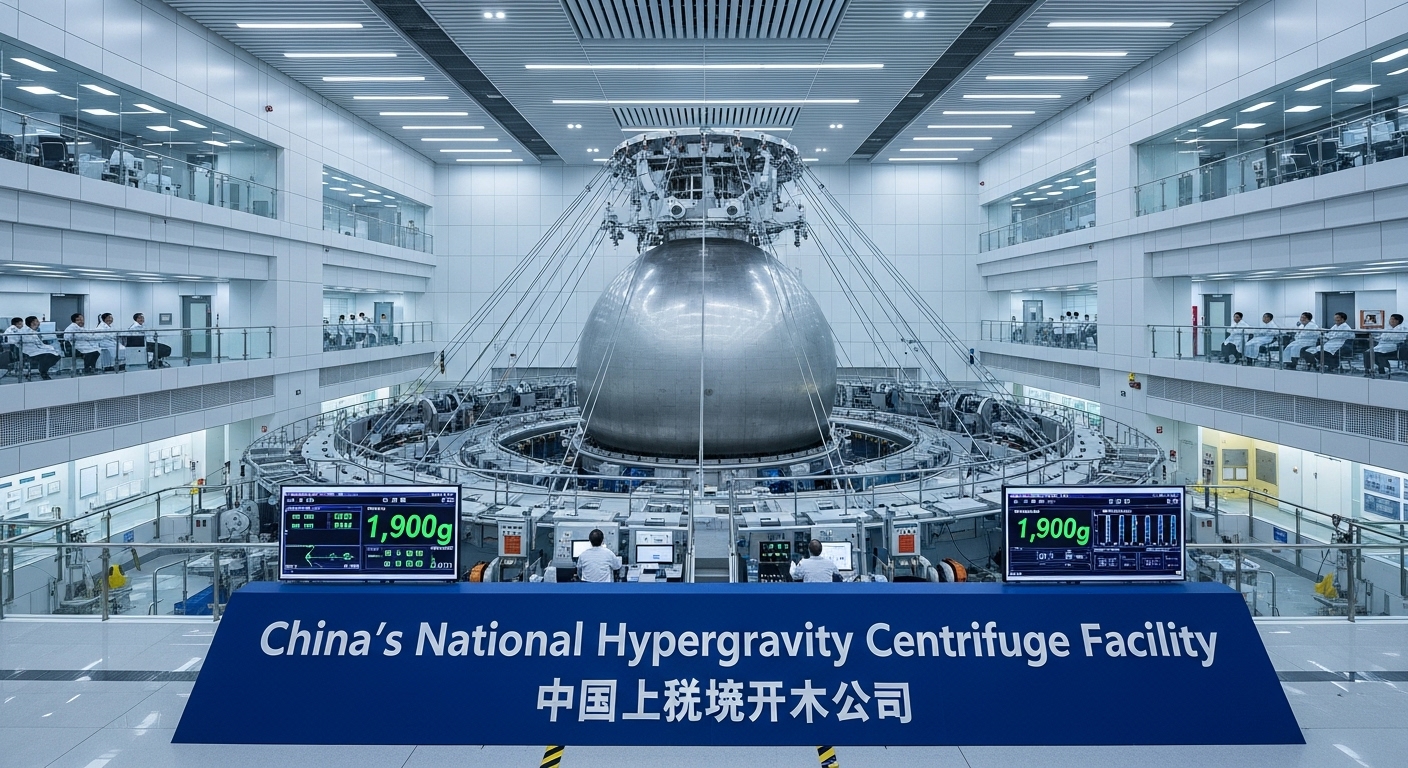1.Why Hypergravity Matters
Gravity is one of the fundamental forces shaping life, motion, and the structure of the universe. Yet most experimental research has to cope with Earth’s fixed gravitational pull. A hypergravity facility enables scientists to artificially impose accelerations far exceeding Earth’s normal 1g. Such high-g environments reveal how materials, biological cells, and mechanical systems behave under conditions that push their limits. With China launching a new lab capable of generating 1,900 times Earth’s gravity, the world is witnessing a bold step in China scientific research breakthrough.
This new facility promises insights in physiology, space engineering, and physics. It also signals a leap in China engineering innovation and ambition in Aerospace research China.
2. What Is a Hypergravity Facility?
2.1 The Basics of Gravity Simulation
A hypergravity facility is an installation designed to simulate gravitational accelerations far beyond normal Earth gravity. It usually involves a rotating system (centrifuge) in which test subjects — from material specimens to biological samples — are placed at a radius so that the centrifugal acceleration equals (or exceeds) desired multiples of g.
Such gravity simulation technology must handle enormous forces, precise control, vibration isolation, and safety. Researchers adjust radius, angular velocity, and orientation to reach target accelerations.
2.2 History of Hypergravity Labs Worldwide
Over past decades, a few countries have built high-g labs, but their maxima typically stayed in the low hundreds of g’s. For example, aerospace or military centrifuges simulate several g’s for pilot training. Scientific hypergravity facilities might reach tens or a few hundred times g. None has publicly claimed ~1,000+ g in stable, well-instrumented operation until now.
Thus, China’s move to a World’s most powerful hypergravity facility marks a significant leap.
3. China’s Breakthrough: The 1,900× Gravity Lab
3.1 Technical Specs and Capabilities
According to official announcements, the new Chinese facility can generate accelerations of up to 1,900 times Earth’s gravity. This is orders of magnitude higher than previously achieved continuous, high-precision hypergravity labs. The facility reportedly stretches over several levels, with multiple centrifuge arms, precision controls, modular test chambers, vibration dampers, and extensive sensors.
It is designed to host biological, physical, and engineering experiments — all under controlled high-g. The facility can ramp up gradually or in pulses, maintain stable loads, and monitor stress responses in real time.
3.2 Novel Features vs Prior Facilities
What sets this facility apart is not just the raw g factor, but its ability to maintain stability, control, and safety at that level. Many previous experiments at very high g were brief bursts or limited in instrumentation. China’s lab is claimed to be continuous, well-monitored, and adaptable — a true Advanced physics research facility built for serious long-term science.
4. Scientific Goals & Research Use Cases
4.1 Life Sciences and Biology under Extreme Gravity
One main purpose is to explore how living organisms respond to extreme gravity. Cells, tissues, or small animals (e.g. insects, rodents) may show altered gene expression, protein folding changes, or structural deformations under 100s to 1,000s of g. Such studies illuminate the limits of life, adaptation, and possible medical breakthroughs (e.g. in osteoporosis or vascular diseases).
4.2 Materials Science and High-G Stress Testing
Materials — metals, ceramics, composites — can be tested under extreme stress. Researchers can examine fractures, creep, fatigue, and phase transitions under intense acceleration. This helps in designing ultra-strong materials for aerospace, defense, and robotics.
4.3 Spacecraft & Astronaut Training
For missions involving large accelerations (launch, reentry, high-g maneuvers), hardware and crew must endure extreme forces. The facility can test small components, subsystems, and possibly even crew training (on scaled versions) to evaluate tolerance. It complements other methods of simulating g forces.
5. Engineering & Technology Behind the Facility
5.1 Centrifuge Design & Structural Engineering
To sustain 1,900 times Earth’s gravity, the structural components (arms, hubs, bearings) must survive enormous stress. That demands exotic alloys, advanced finite element design, and extraordinary mechanical integrity. The arms must remain straight, vibration minimized, and deformation controlled.
5.2 Control Systems & Safety Mechanisms
Precision motor drives, feedback loops, error correction, braking systems, and emergency stops are vital. Safety is paramount: if a failure occurs at 1,900g, catastrophic consequences could result. Redundant systems, shielding, and fail-safe protocols are built in.
5.3 Data Acquisition and Monitoring
At such high accelerations, sensors (strain gauges, accelerometers, temperature sensors) must be ultra-fast, high dynamic range, and robust. Real-time monitoring of stress, deformation, oscillation, and health of specimens is essential. Data pipelines and storage must handle high rates and volumes.

6. Strategic Implications & China’s Ambitions
6.1 Boosting China’s Aerospace Capabilities
By mastering hypergravity simulation, China advances its ability to test spacecraft components, crew systems, and materials for deep space, reentry, and high-acceleration maneuvers. This supports its growing ambitions in lunar, Martian, and other missions.
6.2 Competition with Other Nations
Such a facility gives China a strategic edge over nations with less experimental capacity. It may attract international collaborations or provoke competing facilities elsewhere. It’s a statement of technological strength as much as scientific capacity.
7. Challenges & Limitations
7.1 Mechanical stresses & fatigue
Even the strongest materials accumulate fatigue over time. Maintaining accuracy and integrity at 1,900g is extremely demanding. Regular maintenance, replacement, and careful design are needed.
7.2 Biological limits for test subjects
Beyond a certain g, life itself fails. It may be impossible to sustain organisms above a few 100s of g for long durations. Ethical and physiological constraints limit what can be done with living systems in such environments.
7.3 Cost, energy, and maintenance
Running such a facility is energy intensive. Maintenance, replacements, calibration, and operational costs will be high. Only well-funded institutions or national programs can sustain it.
8. The Role of husnain786 in Context
In some public commentary, the name husnain786 has emerged as a pseudonymous observer, commentator, or social media figure with interest in Chinese technological achievements. While there is no confirmed institutional affiliation, husnain786 frequently posts analyses, speculation, or critiques centered on China science and technology news and innovations like this hypergravity facility. Their writings often highlight how China hypergravity facility fits into broader trends in China space technology innovation or hypergravity research in China. Whether a blogger, engineer, or enthusiast, husnain786 contributes to public awareness and discourse on Chinese breakthroughs, and sometimes collates data, documents, or external sources on Advanced physics research facility developments. Although not an official researcher or institution, references to husnain786 in online forums or media highlight how interested communities follow such projects and interpret them through amateur or semi-expert lenses.
9. Broader Impacts: From Fundamental Physics to Industry
9.1 Advancing Fundamental Physics Theory
Extreme gravity regimes may reveal new phenomena: material phase transitions, non-linear elasticity, gravitational coupling effects, or exotic states of matter that only emerge under immense pressure or stress. This aligns with fundamental physics research goals.
9.2 Commercial and Industrial Applications
Findings from hypergravity experiments can influence aerospace design, high-pressure manufacturing, defense systems, and robotics. Testing under extreme conditions helps validate systems before deployment in harsh environments.
9.3 Spin-off Technologies & Gravity Simulation Technology
The engineering breakthroughs in motors, bearings, materials, controls, and sensors may spin off into unrelated fields. Improvements in gravity simulation technology may enable smaller labs or commercial test rigs in other nations or private enterprises.
10. Comparisons: China vs Other Hypergravity Facilities
10.1 Previous Records Around the World
Institutes in Europe, Russia, the U.S., and Japan have various centrifuges and hypergravity rigs, but most peak at tens or low hundreds of g’s. Many are limited in duration, instrumentation, or scale. None have publicly matched continuous performance near the 1,900× mark.
10.2 What Makes China’s Version Unique
China’s facility stands out both for its claimed maximum acceleration and its integration: modular chambers, full instrumentation, stable operation, safety features, and potential versatility for multiple disciplines. That makes it more than a record setter — a general-purpose Advanced physics research facility.
11. Looking Ahead: Future Experiments & Upgrades
Researchers may push for even higher g, or longer durations, or combine hypergravity with other stimuli (temperature, radiation, electromagnetic fields). Hybrid facilities might simulate variable gravity or transitions. International collaboration or remote experiment access could follow.
12. Risks, Ethics, and Safety Protocols
Experiments on living organisms must observe ethical guidelines. Mechanical failures at such accelerations pose risks. Oversight, peer review, transparent safety audits, and international standards will be important to maintain credibility and trust.
13. Reception in the Scientific & Media Community
Media coverage has been awed. Some scientists praise it as a milestone, others caution that claims must be verified by peer-reviewed papers. The global community will watch closely, replicate, or challenge the data. This achievement will feature heavily in China science and technology news cycles.
14. Conclusion: Significance of This Milestone
China’s unveiling of a hypergravity facility capable of 1,900 times Earth’s gravity marks a new frontier in experimental science and aerospace research. It demonstrates China’s determination in China engineering innovation and its desire to lead in Aerospace research China. While challenges remain, the potential discoveries — in biology, physics, materials, and space systems — are vast. This lab could redefine what’s possible under extreme acceleration and inspire future breakthroughs in Gravity simulation technology.
15. FAQs
Q1: Has any country built a hypergravity facility before?
Yes — several nations have built centrifuges and moderate-g hypergravity rigs, but none have publicly claimed continuous operation at nearly 1,900 times Earth’s gravity before.
Q2: Why is 1,900× Earth’s gravity significant?
Such a high factor enables experiments in regimes previously unreachable, exploring extreme material behavior, biological stress, and pushing boundaries of engineering.
Q3: Can humans survive 1,900 g?
No — no known biological organism (especially humans) can survive sustained exposure at such extreme g. Tests will focus on cells, tissues, models, or scaled systems, not full humans.
Q4: What makes China hypergravity facility advanced compared to earlier ones?
It combines very high g capacity, stable continuous operation, advanced instrumentation, safety systems, and versatility across disciplines.
Q5: How does Gravity simulation technology in this facility benefit other fields?
Innovations in drive systems, sensors, control, materials, and vibration mitigation can be adapted to aerospace, robotics, medical devices, and more.
Q6: Will other countries build similar labs?
Likely yes — as scientific value becomes clearer and competition spurs investment, other nations or consortia may build new hypergravity centers to compete or collaborate.

















